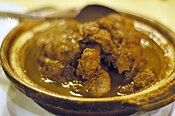Macanese cuisine
This article needs additional citations for verification. (November 2016) |
| Part of a series on the |
| Culture of Macau |
|---|
 |
| History |
| Languages |
| Cuisine |
| Religion |
| Sport |
Macanese cuisine is unique to Macau, and consists of a blend of southern Chinese and Portuguese cuisines, with significant influences from Southeast Asia and the Lusophone world. Many unique dishes resulted from the spice blends that the wives of Portuguese sailors used in an attempt to replicate European dishes. Its ingredients and seasonings include those from Europe, Latin America, Africa, India, and Southeast Asia, as well as local Chinese ingredients.
Common cooking techniques include baking, grilling and roasting. The former, seldom seen in other styles of Chinese cooking, speaks to the eclectic nature of Macanese cooking. Macau is renowned for its flavour-blending culture, and modern Macanese cuisine may be considered a type of fusion cuisine.
Typically, Macanese food is seasoned with various spices including turmeric, coconut milk, cinnamon and bacalhau, giving special aromas and tastes. Famous dishes include Galinha à Portuguesa, Galinha à Africana (African chicken), Bacalhau (traditional Portuguese salt cod),[1] Pato de cabidela, Macanese chili shrimps, Minchi,[2][3][4] and stir-fried curry crab. Other dishes include pig's ear and papaya salad, and rabbit stewed in wine, cinnamon and star anise. Tapas are also an integral part of Macanese cuisine.
The most popular snack is the pork chop bun. The most popular desserts are ginger milk, pastéis de nata (egg tarts), and almond cake.
The famous restaurants of Macau include the Restaurante Porto Interior, Restaurante Litoral, Restaurante Espao and Restaurante O Santos
Macanese dishes
-
Pastéis de nata
-
Pato de cabidela
See also
Select bibliography
- Ferreira Lamas, João António (1995). A culinária dos macaenses. Oporto: Lello & Irmão.
- Gomes, Maria Margarida (1984). A cozinha macaense. Macau: Imprensa Nacional.
- Senna, Maria Celestina de Mello e (1998). Cozinha de Macau. Lisbon: Vega ISBN 972-699-575-2
References
- ^ SILVA, A. J. M. (2015), The fable of the cod and the promised sea. About portuguese traditions of bacalhau, in BARATA, F. T- and ROCHA, J. M. (eds.), Heritages and Memories from the Sea, Proceedings of the 1st International Conference of the UNESCO Chair in Intangible Heritage and Traditional Know-How: Linking Heritage, 14–16 January 2015. University of Evora, Évora, pp. 130-143. PDF version
- ^ [1][dead link]
- ^ [2][dead link]
- ^ [3][dead link]



